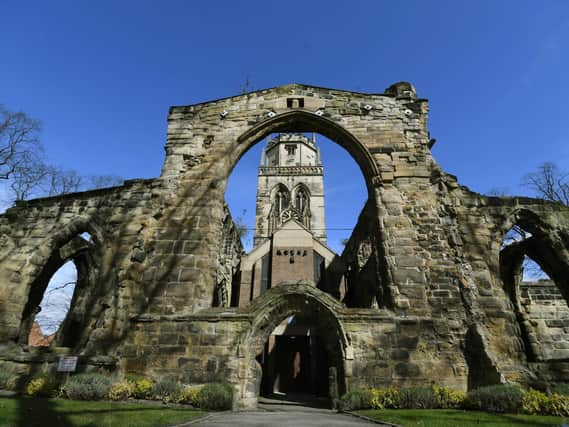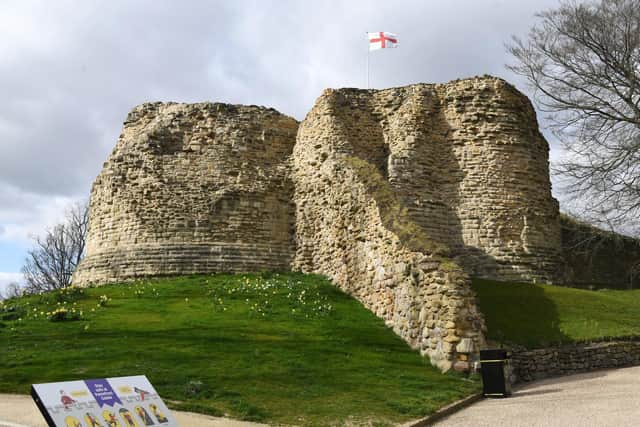Pontefract, the Yorkshire town perhaps best known for liquorice but steeped in history


They are also gloriously self-deprecating, and have nicknamed the place ‘Ponte Carlo’, a jocular reference to its fair share of nightclubs and bars. Indeed, at one time it was reported that Pontefract held the record for the most pubs per square mile in Britain.
There is another motto – Post Mortem Patris Pro Filio – which adorns the town’s coat of arms and translates as “After the father, we hold for the son”. This is generally thought to have been added after the English Civil War during which Oliver Cromwell besieged the castle three times, and declared it one of the most impregnable constructions he’d encountered.
Advertisement
Hide AdAdvertisement
Hide AdTwo things happened after the third siege. The townsfolk refused to kowtow to Cromwell and demonstrated their allegiance to Charles II, the son of Charles I, and added the defiant words to their arms.


They also asked for permission for the castle to be “blighted”, or partly demolished. One siege was bad enough, but three? That was more than enough. Their wishes were carried though and what you see today are some picturesque but still highly impressive hilltop ruins where visitors can easily understand what made the place so strategically important.
That coat of arms is also unusual in that it shows a castle of white stone, but in perspective and not flat on. One tower is to the front, and the other two are on either side. Each has a red banner waving from a squat flagstaff. The castle sits on what appears to be a lake of water, but it is probably a wide moat.
The name Pontefract is derived from the Latin words ‘ponte’ and ‘fractus’, meaning ‘broken bridge’, but wherever that bridge might have been, it cannot have been very big because there is no river of note here. The Romans had a small settlement around here, one of the many staging post forts which lay on the route north from London to York.
Advertisement
Hide AdAdvertisement
Hide Ad‘Ponty’ has been a market town since the middle ages, and there is a fine market hall, as well as many outdoor stalls.
A wealth of excellent architecture still remains and when a post-Second World War rebuild was required a native of the town, the notorious architect John Poulson was called upon to help. Poulson’s “style” was in keeping with the fashionable Brutalism of the 1960s and 70s – stark concrete boxes with square holes punched in them to provide light.
Many regard his buildings as eyesores and some still survive. Luckily, plans to flatten the (then) library were thwarted, and it is now the town’s museum, one of the best examples of flamboyant Art Nouveau in the county.
The designer here was George Pennington, and his stunning flourishes in the exterior decoration, and the interior tiling, are beautifully rendered. Some of the original furniture is still there, and the museum is home to a collection that shows off Pontefract’s social history across the centuries.
Advertisement
Hide AdAdvertisement
Hide AdThis area, to this day, is a colourful jigsaw of enterprises and businesses, and probably the most remarkable of all is the confectionary industry, which has been a tradition here since monks arrived and established their priory. These religious men, who knew much about plants and herbs and their medicinal properties, discovered that the local rich, sandy soil was perfect for growing something rather special – liquorice.
Today, Glycyrrhiza glabra is (largely) an import from Turkey, but for centuries it was grown between the houses in the town. It has been synonymous with the community for so long that it was even celebrated in rhyme by Sir John Betjeman, in his poem The Liquorice Fields at Pontefract.
Life in this corner of Yorkshire hasn’t always been easy. The castle, back in 1399, played host to Richard of Bordeaux, who succeeded to the throne of England at the age of 10. He was the son of the Black Prince who died not long after he was born.
It was a turbulent time and it all ended messily, with Richard’s abdication (he was the first monarch to ‘voluntarily’ relinquish the crown) and the accession of his distant cousin, Henry Bolingbroke, who assumed the title of Henry IV. He sent Richard to Pontefract where, after only a few months within the secure castle walls, he died.
Advertisement
Hide AdAdvertisement
Hide AdHow he met his end is still not entirely clear, but it was his demise that sparked the Wars of the Roses, between the two houses of York and Lancaster. It was a tumultuous period that dragged on for decades and that led to the demise of the Plantagenet dynasty. Shakespeare wrote about it all with his customary flair and called Pontefract “Pomfret” throughout his accounts.
So what else makes Ponty special? It has no less than three railway stations (Baghill, Monkhill and Tanshelf) is unique in having a church built inside a church – when All Saints’ was damaged during the Civil War, the ruins weren’t pulled down and a new place of worship was built within them.
It also has the restored Friarwood Valley Gardens and Pontefract Racecourse, which has the longest continuous horse-racing circuit in Europe, at two miles and 125 yards (Or 16.57 furlongs).
It is a quite remarkable place. The racecourse is perhaps the icing on the cake – a Pontefract Cake, if you like.
Advertisement
Hide AdAdvertisement
Hide AdFor more stories from the YP Magazine and The Yorkshire Post features team, visit our Facebook page.
Editor’s note: first and foremost - and rarely have I written down these words with more sincerity - I hope this finds you well.
Almost certainly you are here because you value the quality and the integrity of the journalism produced by The Yorkshire Post’s journalists - almost all of which live alongside you in Yorkshire, spending the wages they earn with Yorkshire businesses - who last year took this title to the industry watchdog’s Most Trusted Newspaper in Britain accolade.
And that is why I must make an urgent request of you: as advertising revenue declines, your support becomes evermore crucial to the maintenance of the journalistic standards expected of The Yorkshire Post. If you can, safely, please buy a paper or take up a subscription. We want to continue to make you proud of Yorkshire’s National Newspaper but we are going to need your help.
Advertisement
Hide AdAdvertisement
Hide AdPostal subscription copies can be ordered by calling 0330 4030066 or by emailing [email protected]. Vouchers, to be exchanged at retail sales outlets - our newsagents need you, too - can be subscribed to by contacting subscriptions on 0330 1235950 or by visiting www.localsubsplus.co.uk where you should select The Yorkshire Post from the list of titles available.
If you want to help right now, download our tablet app from the App / Play Stores. Every contribution you make helps to provide this county with the best regional journalism in the country.
Sincerely. Thank you.
James Mitchinson